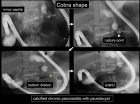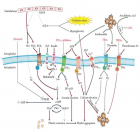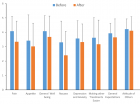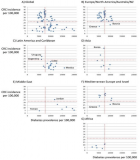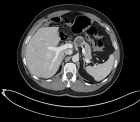Abstract
Review Article
MicroRNA Therapeutics in Triple Negative Breast Cancer
Sarmistha Mitra*
Published: 27 June, 2017 | Volume 1 - Issue 1 | Pages: 009-017
Breast cancer is a complex disease and one of the main causes of cancer-related mortality in women worldwide. In case of approximately 15% of all breast cancers, three markers i.e. estrogen receptors (ER), progesterone receptors (PR) and human epidermal growth factor receptors-2 (HER2) are not expressed, and is commonly termed as triple-negative breast cancer (TNBC). Particularly, TNBC is associated with a higher percentage of breast cancer related mortality, which is often aggressive and most frequently found with a BRCA1 mutation or increased basal marker expression. However, due to the limitations of chemotherapy and radiation based treatment; the current challenge is to establish a new strategy of diagnosis and treatment of TNBC. The deregulation of a number of microRNAs (miRNAs) in breast cancer has been widely reported. Therefore, this review is directed towards enhancing our understanding of the involvement of various miRNAs in the pathology of TNBC, their upregulations and downregulations and the effects on various factors. From recent studies a number of miRNAs are found to be related with TNBC, which have great potential to be used as a biomarker to determine the disease prognosis and predict the fate of disease. Again miRNA can be targeted to be applied as a therapeutic to provide a great benefit to the patients of TNBC by finding a new, safe, and effective treatment strategy.
Read Full Article HTML DOI: 10.29328/journal.hjpcr.1001003 Cite this Article Read Full Article PDF
Keywords:
miRNA; HER2; TNBC; Breast cancer
References
- Akhtar M, Dasgupta S, Rangwala M. Triple negative breast cancer: an Indian perspective. Breast Cancer (Dove Med Press). 2015; 7: 239-243. Ref.: https://goo.gl/qkjztY
- Hudis CA, Gianni L. Triple-negative breast cancer: an unmet medical need. Oncologist. 2011; 16: 1-11. Ref.: https://goo.gl/rCRpbF
- Lips EH, Michaut M, Hoogstraat M, Mulder L, Besselink NJ, et al. Next generation sequencing of triple negative breast cancer to find predictors for chemotherapy response. Breast Cancer Res. 2015; 17: 134. Ref.: https://goo.gl/5VDvxe
- Dent R, Trudeau M, Pritchard KI, Hanna WM, Kahn HK, et al. Triple-negative breast cancer: clinical features and patterns of recurrence. Clin Cancer Res. 2007; 13: 4429-4434. Ref.: https://goo.gl/ixFkXG
- Lin NU, Vanderplas A, Hughes ME, Theriault RL, Edge SB, et al. Clinicopathologic features, patterns of recurrence, and survival among women with triple‐negative breast cancer in the National Comprehensive Cancer Network. Cancer. 2012; 118: 5463-5472. Ref.: https://goo.gl/C2W1Un
- Sachdev JC, Ahmed S, Mirza MM, Farooq A, Kronish L, et al. Does race affect outcomes in triple negative breast cancer? Breast cancer(Auckl). 2010; 4: 23-33. Ref.: https://goo.gl/DPyd2R
- Wei X-Q, Li X, Xin X-J, Tong Z-S, Zhang S. Clinical features and survival analysis of very young (age<35) breast cancer patients. Asian Pacific Journal of Cancer Prevention. 2013; 1: 5949-5952. Ref.: https://goo.gl/MxQDZF
- Thomas K, Shiao J, Rao R, Minhajuddin A, Spangler A, et al. Constructing a Clinicopathologic Prognostic Model for Triple-Negative Breast Cancer. American Journal of Hematology/Oncology®, 2017; 13: 11-21. Ref.: https://goo.gl/da2Ue8
- Iorio MV, Ferracin M, Liu CG, Veronese A, Spizzo R, et al. MicroRNA gene expression deregulation in human breast cancer. Cancer res. 2005; 65: 7065-7070. Ref.: https://goo.gl/AWPv6j
- Schwarzenbacher D, Balic M, Pichler M. The role of microRNAs in breast cancer stem cells. Int J Mol Sci. 2013; 14: 14712-14723. Ref.: https://goo.gl/2ZLHWG
- Serpico D, Molino L Di, Cosimo S. microRNAs in breast cancer development and treatment. Cancer Treat Rev. 2014; 40: 595-604. Ref.: https://goo.gl/KNeCPB
- Stover DG, Winer EP. Tailoring adjuvant chemotherapy regimens for patients with triple negative breast cancer. Breast. 2015; 24: 132-135. Ref.: https://goo.gl/RWURDL
- Badve S, Dabbs DJ, Schnitt SJ, Baehner FL, Decker T, et al. Basal-like and triple-negative breast cancers: a critical review with an emphasis on the implications for pathologists and oncologists. Modern Pathology. 2011; 24: 157-167. Ref.: https://goo.gl/YYuZYo
- Banerjee S, Reis-Filho JS, Ashley S, Steele D, Ashworth A, et al. Basal-like breast carcinomas: clinical outcome and response to chemotherapy. J Clin Pathol. 2006; 59: 729-735. Ref.: https://goo.gl/ox1RqW
- Irvin WJ, Carey LA. What is triple-negative breast cancer? Eur J Cancer. 2008; 44: 2799-2805. Ref.: https://goo.gl/m7Tysk
- Rakha EA, El‐Sayed ME, Green AR, Lee AH, Robertson JF, et al. Prognostic markers in triple‐negative breast cancer. Cancer. 2007a; 109: 25-32. Ref.: https://goo.gl/G3oWcS
- Rakha EA, Tan DS, Foulkes WD, Ellis IO, Tutt A, at el. Are triple-negative tumours and basal-like breast cancer synonymous? Breast cancer research. 2007b; 9: 404. Ref.: https://goo.gl/VKeMR6
- Sorlie T, Tibshirani R, Parker J, Hastie T, Marron J, et al. Repeated observation of breast tumor subtypes in independent gene expression data sets. Proc Natl Acad Sci USA. 2003; 100: 8418-8423. Ref.: https://goo.gl/XGzMaq
- Fackenthal JD, Olopade OI. Breast cancer risk associated with BRCA1 and BRCA2 in diverse populations. Nat Rev Cancer. 2007; 7: 937-948. Ref.: https://goo.gl/rqLiiJ
- Fadare O, Tavassoli FA. Clinical and pathologic aspects of basal-like breast cancers. Nat Clin Pract Oncol. 2008; 5: 149-159. Ref.: https://goo.gl/rbTDYf
- Bertucci F, Finetti P, Cervera N, Esterni B, Hermitte F, et al. How basal are triple‐negative breast cancers? Int J Cancer. 2008; 123: 236-240. Ref.: https://goo.gl/zLpZxL
- Calza S, Hall P, Auer G, Bjöhle J, Klaar S, et al. Intrinsic molecular signature of breast cancer in a population-based cohort of 412 patients. Breast Cancer Res. 2006; 8: R34. Ref.: https://goo.gl/zAJs3q
- Hashmi AA, Edhi MM, Naqvi H, Faridi N, Khurshid A, et al. Clinicopathologic features of triple negative breast cancers: an experience from Pakistan. Diagn Pathol. 2014; 9: 43. Ref.: https://goo.gl/CbeVRJ
- Cheng H, Qin Y, Fan H, Su P, Zhang X, et al. Overexpression of CARM1 in breast cancer is correlated with poorly characterized clinicopathologic parameters and molecular subtypes. Diagn Pathol. 2013; 8: 129. Ref.: https://goo.gl/YcLpjk
- Klingen TA, Chen Y, Suhrke P, Stefansson IM, Gundersen MD, et al. Expression of thyroid transcription factor-1 is associated with a basal-like phenotype in breast carcinomas. Diagn Pathol. 2013; 8: 80. Ref.: https://goo.gl/BCFoZv
- Liu L, Liu Z, Qu S, Zheng Z, Liu, et al. Small breast epithelial mucin tumor tissue expression is associated with increased risk of recurrence and death in triple-negative breast cancer patients. Diagn Pathol. 2013b; 8: 71. Ref.: https://goo.gl/Zs3pTt
- Nass N, Dittmer A, Hellwig V, Lange T, Beyer JM, et al. Expression of transmembrane protein 26 (TMEM26) in breast cancer and its association with drug response. Oncotarget. 2016; 7: 38408-38426. Ref.: https://goo.gl/QVgCfH
- Yamagishi Si, Matsui T, Fukami K. Role of receptor for advanced glycation end products (RAGE) and its ligands in cancer risk. Rejuvenation Res. 2015; 18: 48-56. Ref.: https://goo.gl/UkVvuy
- Radia A-M, Yaser A-M, Ma X, Zhang J, Yang C, et al. Specific siRNA targeting receptor for advanced glycation end products (RAGE) decreases proliferation in human breast cancer cell lines. Int J Mol Sci. 2013; 14: 7959-7978. Ref.: https://goo.gl/CmgGy4
- Svoboda M, Sana J, Redova M, Navratil J, Palacova M, et al. MiR-34b is associated with clinical outcome in triple-negative breast cancer patients. Diagn Pathol. 2012; 7: 31. Ref.: https://goo.gl/YZJ4Rb
- Laurinavicius A, Laurinaviciene A, Ostapenko V, Dasevicius D, Jarmalaite S, et al. Immunohistochemistry profiles of breast ductal carcinoma: factor analysis of digital image analysis data. Diagn Pathol. 2012; 7: 27. Ref.: https://goo.gl/Cv32X7
- Livasy CA, Karaca G, Nanda R, Tretiakova MS, Olopade OI, et al. Phenotypic evaluation of the basal-like subtype of invasive breast carcinoma. Mod Pathol. 2006; 19: 264-271. Ref.: https://goo.gl/x6U4g8
- Fulford L, Easton D, Reis‐Filho J, Sofronis A, Gillett C, et al. Specific morphological features predictive for the basal phenotype in grade 3 invasive ductal carcinoma of breast. Histopathology. 2006; 49: 22-34. Ref.: https://goo.gl/wNDjAk
- Reis‐Filho JS, Milanezi F, Steele D, Savage K, Simpson PT, et al. Metaplastic breast carcinomas are basal‐like tumours. Histopathology. 2006; 49: 10-21. Ref.: https://goo.gl/7yuofu
- Cleator S, Heller W, Coombes RC. Triple-negative breast cancer: therapeutic options. Lancet Oncol. 2007; 8: 235-244. Ref.: https://goo.gl/bTe5m9
- Carter M, Hornick JL, Lester S, Fletcher CD. Spindle cell (sarcomatoid) carcinoma of the breast: a clinicopathologic and immunohistochemical analysis of 29 cases. Am J Surg Pathol. 2006; 30: 300-309. Ref.: https://goo.gl/UYu7xG
- Wargotz ES, Norris HJ. Metaplastic carcinomas of the breast. IV. Squamous cell carcinoma of ductal origin. Cancer. 1990a; 65: 272-276. Ref.: https://goo.gl/ZhMcrA
- Rosen PP, Ernsberger D. Low-Grade Adenosquamous Carcinoma: A Variant of Metaplastic Mammary Carcinoma. Am J Surg Pathol. 1987; 11: 351-358. Ref.: https://goo.gl/jbrMzF
- Hanna W, Kahn HJ. Ultrastructural and immunohistochemical characteristics of mucoepidermoid carcinoma of the breast. Hum Pathol. 1985; 16: 941-946. Ref.: https://goo.gl/z1AY4D
- Wargotz ES, Norris HJ. Metaplastic carcinomas of the breast: V. Metaplastic carcinoma with osteoclastic giant cells. Hum Pathol. 1990b; 21: 1142-1150. Ref.: https://goo.gl/2PU5oL
- Sneige N, Yaziji H, Mandavilli SR, Perez ER, Ordonez NG, et al. Low-grade (fibromatosis-like) spindle cell carcinoma of the breast. Am J Surg Pathol. 2001; 25: 1009-1016. Ref.: https://goo.gl/JVCMpx
- Ferracin M, Veronese A, Negrini M. Micromarkers: miRNAs in cancer diagnosis and prognosis. Expert Rev Mol Diagn. 2010; 10: 297-308. Ref.: https://goo.gl/21xJAU
- Le X-F, Merchant O, Bast RC, Calin, GA. The roles of microRNAs in the cancer invasion-metastasis cascade. Cancer Microenviron. 2010; 3:137-147. Ref.: https://goo.gl/S73wzr
- Negrini M, Calin GA. Breast cancer metastasis: a microRNA story. Breast Cancer Res. 2008; 10: 203. Ref.: https://goo.gl/H727oi
- Blenkiron C, Goldstein LD, Thorne NP, Spiteri I, Chin SF, et al. MicroRNA expression profiling of human breast cancer identifies new markers of tumor subtype. Genome Biol. 2007; 8: 214.Ref.: https://goo.gl/J2kvV8
- Van Schooneveld E,Wildiers H, Vergote I, Vermeulen PB, Dirix LY, et al. Dysregulation of microRNAs in breast cancer and their potential role as prognostic and predictive biomarkers in patient management. Breast Cancer Res. 2015; 17: 21. Ref.: https://goo.gl/eRZ3Dz
- Lehmann BD, Bauer JA, Chen X. Sanders ME, Chakravarthy AB, et al. Identification of human triple-negative breast cancer subtypes and preclinical models for selection of targeted therapies. J Clin Invest. 2011; 121: 2750-2767. Ref.: https://goo.gl/JdPQuW
- Kurozumi S, Yamaguchi Y, Kurosumi M, Ohira M, Matsumoto H, et al. Recent trends in microRNA research into breast cancer with particular focus on the associations between microRNAs and intrinsic subtypes. J Hum Genet. 2017; 62: 15-24. Ref.: https://goo.gl/2beH8d
- Garcia AI, Buisson M, Bertrand P, Rimokh R, Rouleau E, et al. Down‐regulation of BRCA1 expression by miR‐146a and miR‐146b‐5p in triple negative sporadic breast cancers. EMBO Mol Med. 2011b; 3: 279-290. Ref.: https://goo.gl/uyDCs7
- Garcia AI, Buisson M, Bertrand P, Rimokh R, Rouleau E. Down-regulation of BRCA1 expression by miR-146a and miR-146b-5p in triple negative sporadic breast cancers. EMBO Mol Med. 2011a; 3: 279-290. Ref.: https://goo.gl/b6LLyy
- Shen J, Ambrosone CB, DiCioccio RA, Odunsi K, Lele SB, et al. A functional polymorphism in the miR-146a gene and age of familial breast/ovarian cancer diagnosis. Carcinogenesis. 2008; 29: 1963-1966. Ref.: https://goo.gl/vsxoFy
- Crippa E, Lusa L, De Cecco L, Marchesi E, Calin GA, et al. miR-342 regulates BRCA1 expression through modulation of ID4 in breast cancer. PloS one. 2014; 9. Ref.: https://goo.gl/hGwK4D
- Moskwa P, Buffa FM, Pan Y, Panchakshari R, Gottipati P, et al. miR-182-mediated downregulation of BRCA1 impacts DNA repair and sensitivity to PARP inhibitors. Mol Cell. 2011; 41: 210-220. Ref.: https://goo.gl/hcRb6n
- Tanic M, Yanowski K, Gómez‐López G, Rodriguez‐Pinilla MS, Marquez‐Rodas I, et al. MicroRNA expression signatures for the prediction of BRCA1/2 mutation‐associated hereditary breast cancer in paraffin‐embedded formalin‐fixed breast tumors. Int J Cancer. 2015; 136: 593-602. Ref.: https://goo.gl/grGd5T
- Rodriguez A, Vigorito E, Clare S, Warren MV, Couttet P, et al. Requirement of bic/microRNA-155 for normal immune function. Science. 2007; 316: 608-611. Ref.: https://goo.gl/GF482e
- Zonari E, Pucci F, Saini M, Mazzieri R, Politi LS, et al. A role for miR-155 in enabling tumor-infiltrating innate immune cells to mount effective anti-tumor responses. Blood. 2013. Ref.: https://goo.gl/hGCSBT
- Gregory PA, Bert AG, Paterson EL, Barry SC, Tsykin A, et al. The miR-200 family and miR-205 regulate epithelial to mesenchymal transition by targeting ZEB1 and SIP1. Nat Cell Biol. 2008; 10: 593-601. Ref.: https://goo.gl/zVDmYo
- Gebeshuber CA, Zatloukal K, Martinez J. miR‐29a suppresses tristetraprolin, which is a regulator of epithelial polarity and metastasis. EMBO Rep. 2009; 10: 400-405. Ref.: https://goo.gl/441YmF
- Jiang H, Zhang G, Wu JH, Jiang CP. Diverse roles of miR-29 in cancer (review). Oncol Rep. 2014; 31: 1509-1516. Ref.: https://goo.gl/fnLsKJ
- Gaur AB, Holbeck SL, Colburn NH, Israel MA. Downregulation of Pdcd4 by mir-21 facilitates glioblastoma proliferation in vivo. Neuro Oncol. 2011; 13: 580-590. Ref.: https://goo.gl/byJacU
- Wang Q, Liu S, Tang Y, Liu Q, Yao Y. MPT64 protein from Mycobacterium tuberculosis inhibits apoptosis of macrophages through NF-kB-miRNA21-Bcl-2 pathway. PloS one. 2014; 9. Ref.: https://goo.gl/aJ5xsF
- Lim PK, Bliss SA, Patel SA, Taborga M, Dave MA, et al. Gap junction-mediated import of MicroRNA from bone marrow stromal cells can elicit cell cycle quiescence in breast cancer cells. Cancer Res. 2011; 71: 1550-1560. Ref.: https://goo.gl/pvkf4M
- Eichelser C, Stuckrath I, Muller V, Milde-Langosch K, Wikman H, et al. Increased serum levels of circulating exosomal microRNA-373 in receptor-negative breast cancer patients. Oncotarget. 2014; 5: 9650-9663. Ref.: https://goo.gl/hTpniA
- Chen J, Shin VY, Siu MT, Ho JC, Cheuk I, et al. miR-199a-5p confers tumor-suppressive role in triple-negative breast cancer. BMC cancer. 2016; 16: 887. Ref.: https://goo.gl/JRTnbS
- Abdellatif M. Differential expression of microRNAs in different disease states. Circ Res. 2012; 110: 638-650. Ref.: https://goo.gl/8DbLUY
- Kaboli PJ, Rahmat A, Ismail P, Ling KH. MicroRNA-based therapy and breast cancer: A comprehensive review of novel therapeutic strategies from diagnosis to treatment. Pharmacol Res. 2015; 97: 104-121. Ref.: https://goo.gl/2KEucF
- Kim NH, Kim HS, Li XY, Lee I, Choi HS, et al. A p53/miRNA-34 axis regulates Snail1-dependent cancer cell epithelial-mesenchymal transition. J Cell Biol. 2011; 195: 417-433. Ref.: https://goo.gl/16dmCU
- Song SJ, Poliseno L, Song MS, Ala U, Webster K, et al. MicroRNA-antagonism regulates breast cancer stemness and metastasis via TET-family-dependent chromatin remodeling. Cell. 2013; 154: 311-324. Ref.: https://goo.gl/mFpe5j
- Graveel CR, Calderone HM, Westerhuis JJ, Winn ME, Sempere LF. Critical analysis of the potential for microRNA biomarkers in breast cancer management. Breast Cancer (Dove Med Press). 2015; 7: 59-79. Ref.: https://goo.gl/MeC4Ze
- Ma L, Teruya-Feldstein J, Weinberg RA. Tumour invasion and metastasis initiated by microRNA-10b in breast cancer. Nature. 2007; 449: 682-688. Ref.: https://goo.gl/T28Wx1
- Li X, Pan YZ, Seigel GM, Hu ZH, Huang M, et al. Breast cancer resistance protein BCRP/ABCG2 regulatory microRNAs (hsa-miR-328,-519c and-520h) and their differential expression in stem-like ABCG2+ cancer cells. Biochem Pharmacol. 2011; 81: 783-792. Ref.: https://goo.gl/AJpbNX
- Amschler K, Schön MP, Pletz N, Wallbrecht K, Erpenbeck L, et al. NF-κB inhibition through proteasome inhibition or ikkβ blockade increases the susceptibility of melanoma cells to cytostatic treatment through distinct pathways. Journal of Investigative Dermatology. 2010; 130: 1073-1086. Ref.: https://goo.gl/4LZLsx
- Eichelser C, Stückrath I, Müller V, Milde-Langosch K, Wikman H, et al. Increased serum levels of circulating exosomal microRNA-373 in receptor-negative breast cancer patients. Oncotarget. 2014b; 5: 9650-9663. Ref.: https://goo.gl/rHgdDT
- Gabriely G, Teplyuk NM, Krichevsky AM. Context effect: microRNA-10b in cancer cell proliferation, spread and death. Autophagy. 2011; 7: 1384-1386. Ref.: https://goo.gl/JeGrjH
- Lee KH, Goan YG, Hsiao M, Lee CH, Jian SH, et al. MicroRNA-373 (miR-373) post-transcriptionally regulates large tumor suppressor, homolog 2 (LATS2) and stimulates proliferation in human esophageal cancer. Exp Cell Res. 2009; 315: 2529-2538. Ref.: https://goo.gl/pQ5E1y
- Okoye JO, Okoye FO. miRNA and Target Oncogene Regulation in Triple Negative Breast Cancer: An Age, Ethnic and Environmental Related Neoplastic Event. JCTI. 2015; 2: 66-80. Ref.: https://goo.gl/LAue9x
- Radojicic J, Zaravinos A, Vrekoussis T, Kafousi M, Spandidos DA, et al. MicroRNA expression analysis in triple-negative (ER, PR and Her2/neu) breast cancer. Cell cycle. 2011; 10: 507-517. Ref.: https://goo.gl/epHQG9
- Wang Y, Rathinam R, Walch A, Alahari SK. ST14 (suppression of tumorigenicity 14) gene is a target for miR-27b, and the inhibitory effect of ST14 on cell growth is independent of miR-27b regulation. J Biol Chem. 2009; 284: 23094-23106. Ref.: https://goo.gl/d2hUNM
- Wu Q, Wang C, Lu Z, Guo L, Ge Q. Analysis of serum genome-wide microRNAs for breast cancer detection. Clin Chim acta. 2012; 413: 1058-1065. Ref.: https://goo.gl/rZXH2c
- Zavala V, Pérez-Moreno E, Tapia T, Camus M, Carvallo P. MiR-146a and miR-638 in BRCA1-deficient triple negative breast cancer tumors, as potential biomarkers for improved overall survival. Cancer Biomarkers. 2016; 16: 99-107. Ref.: https://goo.gl/Tm2PTf
- Liu H, Wang Y, Li X, Zhang Y-j, Li J, et al. Expression and regulatory function of miRNA182 in triple-negative breast cancer cells through its targeting of profilin 1. Tumour Biol. 2013a; 34: 1713-1722. Ref.: https://goo.gl/hVysfE
- Mattiske S, Suetani RJ, Neilsen PM, Callen DF. The oncogenic role of miR-155 in breast cancer. Cancer Epidemiol Biomarkers Prev. 2012; 21: 1236-1243. Ref.: https://goo.gl/5FGVmG
- Ding L, Ni J, Yang F, Huang L, Deng H, et al. Promising therapeutic role of miR-27b in tumor. Tumour Biol. 2017; 39. Ref.: https://goo.gl/DhSVYM
- Jin L, Wessely O, Marcusson EG, Ivan C, Calin GA, et al. Prooncogenic factors miR-23b and miR-27b are regulated by Her2/Neu, EGF, and TNF-α in breast cancer. Cancer Res. 2013; 73: 2884-2896. Ref.: https://goo.gl/JHqgXT
- Fkih M'hamed I, Privat M, Ponelle F, Penault-Llorca F, Kenani A. Identification of miR-10b, miR-26a, miR-146a and miR-153 as potential triple-negative breast cancer biomarkers. Cell Oncol (Dordr). 2015; 38: 433-442.Ref.: https://goo.gl/HxFqof
- Fkih M'hamed I, Privat M, Trimeche M, Penault-Llorca F, Bignon YJ. et al. miR-10b, miR-26a, miR-146a And miR-153 Expression in Triple Negative Vs Non Triple Negative Breast Cancer: Potential Biomarkers. Pathol Oncol Res. 2017. Ref.: https://goo.gl/7y1JFS
Similar Articles
-
MicroRNA Therapeutics in Triple Negative Breast CancerSarmistha Mitra*. MicroRNA Therapeutics in Triple Negative Breast Cancer . . 2017 doi: 10.29328/journal.hjpcr.1001003; 1: 009-017
-
Rosai-Dorfman disease presenting as a breast massDing Dai*,Qi Cai, Nasreen A. Vohra,Jan Wong, Zsuzsanna P. Therien,Karlene Hewan-Lowe,Ann Sutton. Rosai-Dorfman disease presenting as a breast mass . . 2019 doi: 10.29328/journal.apcr.1001012; 3: 008-014
Recently Viewed
-
Seismic Analysis of Semi-rigid Frames using Skeleton JointsCai Zi,Sun Menghan*,Zhang Chunhui,He luyao,Yang Zailin. Seismic Analysis of Semi-rigid Frames using Skeleton Joints. Ann Civil Environ Eng. 2025: doi: 10.29328/journal.acee.1001083; 9: 073-079
-
Scientific Analysis of Eucharistic Miracles: Importance of a Standardization in EvaluationKelly Kearse*,Frank Ligaj. Scientific Analysis of Eucharistic Miracles: Importance of a Standardization in Evaluation. J Forensic Sci Res. 2024: doi: 10.29328/journal.jfsr.1001068; 8: 078-088
-
Transnasal Humidified Rapid-Insufflation Ventilatory Exchange (THRIVE) in High-Risk Endoscopic Procedures: A Non-Intubation ApproachNaba Madoo*,Vaibhavi Baxi. Transnasal Humidified Rapid-Insufflation Ventilatory Exchange (THRIVE) in High-Risk Endoscopic Procedures: A Non-Intubation Approach. Int J Clin Anesth Res. 2025: doi: 10.29328/journal.ijcar.1001033; 9: 035-036
-
A Strength-based Approach to Achieving Academic Success for Individuals with Autism Spectrum Disorder (ASD)Sally M Reis*, Nicholas Gelbar, Joseph Madaus. A Strength-based Approach to Achieving Academic Success for Individuals with Autism Spectrum Disorder (ASD). J Neurosci Neurol Disord. 2024: doi: 10.29328/journal.jnnd.1001090; 8: 010-011
-
Why is Pain not Characteristic of Inflammation of the Lung Tissue?Igor Klepikov*. Why is Pain not Characteristic of Inflammation of the Lung Tissue?. J Clin Intensive Care Med. 2024: doi: 10.29328/journal.jcicm.1001046; 9: 005-007
Most Viewed
-
Feasibility study of magnetic sensing for detecting single-neuron action potentialsDenis Tonini,Kai Wu,Renata Saha,Jian-Ping Wang*. Feasibility study of magnetic sensing for detecting single-neuron action potentials. Ann Biomed Sci Eng. 2022 doi: 10.29328/journal.abse.1001018; 6: 019-029
-
Evaluation of In vitro and Ex vivo Models for Studying the Effectiveness of Vaginal Drug Systems in Controlling Microbe Infections: A Systematic ReviewMohammad Hossein Karami*, Majid Abdouss*, Mandana Karami. Evaluation of In vitro and Ex vivo Models for Studying the Effectiveness of Vaginal Drug Systems in Controlling Microbe Infections: A Systematic Review. Clin J Obstet Gynecol. 2023 doi: 10.29328/journal.cjog.1001151; 6: 201-215
-
Prospective Coronavirus Liver Effects: Available KnowledgeAvishek Mandal*. Prospective Coronavirus Liver Effects: Available Knowledge. Ann Clin Gastroenterol Hepatol. 2023 doi: 10.29328/journal.acgh.1001039; 7: 001-010
-
Causal Link between Human Blood Metabolites and Asthma: An Investigation Using Mendelian RandomizationYong-Qing Zhu, Xiao-Yan Meng, Jing-Hua Yang*. Causal Link between Human Blood Metabolites and Asthma: An Investigation Using Mendelian Randomization. Arch Asthma Allergy Immunol. 2023 doi: 10.29328/journal.aaai.1001032; 7: 012-022
-
An algorithm to safely manage oral food challenge in an office-based setting for children with multiple food allergiesNathalie Cottel,Aïcha Dieme,Véronique Orcel,Yannick Chantran,Mélisande Bourgoin-Heck,Jocelyne Just. An algorithm to safely manage oral food challenge in an office-based setting for children with multiple food allergies. Arch Asthma Allergy Immunol. 2021 doi: 10.29328/journal.aaai.1001027; 5: 030-037

HSPI: We're glad you're here. Please click "create a new Query" if you are a new visitor to our website and need further information from us.
If you are already a member of our network and need to keep track of any developments regarding a question you have already submitted, click "take me to my Query."







